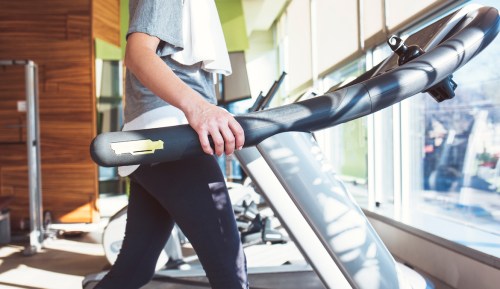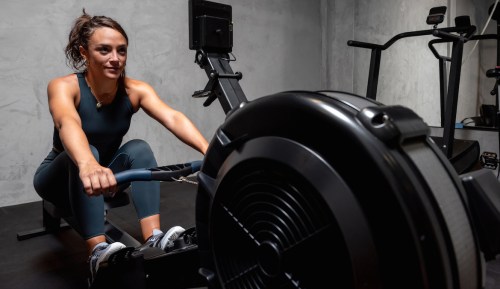Strength training may be having its moment again (and rightfully so!), but there's still a place for cardio in your workout rotation.
Besides supporting heart health, longevity (looking at you Vo2 max), brain health, mood, and so much more—there's no shortage of reasons to do more cardio. No matter if you fall in the "love it" or "hate it" camp, cardio exercise can deliver a mood-boosting cocktail of endorphins and an energy boost that is hard to find in other modalities. So if you're looking to increase your cardio, whether it's to meet the 150 minutes a week recommended by the CDC, or just to feel better and boost your health, you may be considering cardio equipment like the elliptical machine or treadmill.
So, what's the big difference between a treadmill vs. elliptical? The two machines have some key differences and pros and cons to consider. Before jumping on one machine over the other, dive into the expert-vetted advice below to find out which is best for you.
Elliptical vs Treadmill: How to Pick the Best Cardio Machine
Ellipticals and treadmills both offer effective and safe forms of cardio exercise. Treadmills tend to offer more variety, but can also be higher-impact on your joints. Elliptical machines are low-impact, but offer less variety in terms of the kinds of workouts you can do on the machines.
"The main difference between these two is the impact on the joints," says Mollie Millington, a certified personal trainer and running coach. "The treadmill will add more impact, so if you are looking for a weight-bearing exercise or are training for a specific type of footrace, the treadmill may be the better fit. The elliptical offers more support for your joints, so it may be best if you are new to exercise or have a history of injuries," she says.
Before diving into all the key differences between ellipticals vs. treadmills, you'll want to consider a few key factors. Some things to think about: Your goals, overall likes and dislikes, any limitations or injuries you may have, and consider how much variety you need in your workout routine. More on all of this below.
Know Your Goals
Starting with the end in mind is common advice—and when it comes to exercise, it's no different. So when considering whether a treadmill or elliptical may be best for you, thinking about your ultimate goal or goals can help. For example, do you want to run in a 5K race or half-marathon someday? Or, maybe you have a history of injuries or joint pain and prefer lower-impact exercise. Do you want to incorporate HIIT into your routine?
Knowing what you ultimately want to accomplish and get out of your workouts is key here and a great place to start when considering if a treadmill or elliptical is right for you.
What Are Your Preferences?
The best type of exercise for you may be different than what your friend or someone else enjoys. "You don't have to follow trends. An exercise you enjoy is one that you will want to do more of," says Millington. This is where some trial and error can be helpful. Consider trying out a few different types of workouts on each piece of equipment and take note of which one you enjoy more. Again, enjoyment means a greater likelihood you'll stick to (and stay consistent) with your routine.
Here's What You Need to Know About Elliptical Workouts
Ellipticals are cardio exercise machines that require you to use your upper body and lower body at the same time as you move. During an elliptical workout, you will grab onto handles with your hands and push and pull with your upper body, as your legs (with your feet positioned inside pedals or foot rests) push and pull at the same time. The elliptical engages your full body since your upper and lower body power the movement, while your core helps stabilize you as you move.
Pros of Elliptical Workouts
Elliptical machines offer plenty of benefits, like the ones below.
- Full-Body Workout: One of the biggest benefits of the elliptical machine is its efficiency. When you use an elliptical, you get a cardiovascular workout, and engage nearly all of your major muscle groups since you're working both your arms and legs while using the machine. Your core also helps stabilize you, meaning you also get some ab-work while on the machine.
- Low-Impact: While it's still considered a weight-bearing exercise, an elliptical machine puts less impact on your joints since your feet are supported in the pedals.
- Beginner-Friendly: If you're new to exercise or getting back into it after a break, an elliptical is a great place to start since the machine is relatively easy to use and workouts are adaptable based on your fitness level. It does take some getting used to the movement, but once you get the hang of it, you're set.
Cons of Elliptical Workouts
- Not As Much Variety: If you like a lot of variety in your workouts, you may prefer a treadmill since you have more options to switch up your workouts. Ellipticals offer some variety, but again, it is more limited due to the way the machine works.
- Repetitive Motion: If you have shoulder or elbow issues, you may have some issues with the repetitive motion required by an elliptical machine, per Harvard Health.
Now, a Quick Rundown of What You Should Know About Treadmill Workouts
Treadmills are tried and true classics when it comes to cardio. Treadmills can have motorized or manual functions, and also vary in how much space they take up, as well as in different belt lengths. There's no shortage of options when it comes to finding the best treadmill. Features on treadmills can vary by machine, but in general, you can control speed and incline, which means you can do everything from walks, to runs, to "hikes" on treadmills.
Pros of Treadmill Workouts
Treadmills are a classic for a reason: they're effective, offer versatile workouts, and are relatively safe when you use them correctly. Below, more on all the benefits treadmills offer.
- Versatile: Walk, run, sprints, HIIT workouts, intervals…the options are nearly endless when it comes to the types of workouts you can do on the treadmill.
- Good for All Levels: No matter if you prefer walking or have run marathons, treadmills work for nearly all fitness levels. You can start with walking workouts, progress to jogs, or skip to sprinting if you're more advanced.
- Customizable: The number of features you can customize on the treadmill depends on the brand, but in general, you can adjust incline and speed to your preferences.
- Can Help You Train for a Race: Treadmills offer obvious perks for runners, since you can use them to train for races and work on your speed, endurance, and stamina indoors. "[Treadmills] can also help you 'learn' a new pace by getting your body used to a consistent rhythm, which is hard to find outdoors with traffic lights, people on the sidewalk, and curbs," says Millington.
Cons of Treadmill Workouts
- Greater impact: The main drawback when it comes to treadmills is that the machine tends to be higher-impact on your joints. Although compared to running outside on pavement, some treadmills offer more advanced cushioning that can help take some of the impact off of your joints.
- Requires Balance: If you have any challenges or issues with balance, a treadmill can require a bit more balance compared to an elliptical. "If you are worried about balance, the handles on a treadmill may give you a bit more confidence, too," adds Millington.
Expert Tips for Getting the Most Out of Your Elliptical or Treadmill Workout
The two most important tips for getting the most out of your cardio workouts on an elliptical or treadmill are consistency and form.
First, Millington stresses the importance of consistency when it comes to reaping all of the benefits that cardio exercise offers. "To get the most out of the cardio workouts, you need to be consistent. Whether [you start] with 5 minutes a day, then you build to 10, then 25, then 30 minutes three times a week–getting on the equipment is the first step to getting the most out of your cardio workout," says Millington.
When using an elliptical, good form tips to keep in mind include thinking about engaging your core, keeping your shoulders down and back (avoid letting them shrug up towards your shoulders), and avoiding leaning side to side, as previously reported in Well+Good.
For both machines, it's a good idea to get to know the safety features before hopping on. If you're unsure of how a machine works, always consult a qualified fitness professional or certified trainer first.
Treadmills vs Ellipticals: Which Is Best For You?
Treadmills and ellipticals both offer effective and safe cardio workouts. Choosing one that is best for you depends on your goals, personal preferences, and individual needs. If you don't have access to a gym where you can test both an elliptical and a treadmill, consider whether you enjoy walking or running workouts. If so, a treadmill may be best for you, especially if you like working out outdoors and want an option to work out inside. If you're unsure of your preference, but know your priority is getting a low-impact, full-body workout, an elliptical may be better for you.
Before deciding on one machine over the other, try both to get a feel for which one may be right for you. And if you can't decide, there's no need to choose one over the other—both can be incorporated in a fitness program, and you may even enjoy the variety both machines add to your routine.
Sign Up for Our Daily Newsletter
Get all the latest in wellness, trends, food, fitness, beauty, and more delivered right to your inbox.
Got it, you've been added to our email list.










